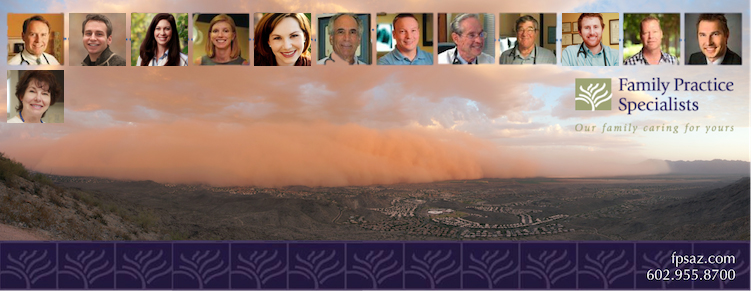Valley Fever is a confusing subject for many Arizona residents. In fact, it can be confusing for many Phoenix physicians as well if they are inexperienced on the topic. One day EVB Live will tell you that Valley Fever cases are dropping in the valley, and on the same day but on Fox 10 the newscaster tells you that cases of Valley Fever are on the rise. How can that be? How can one virus confuse so many people? Why is Valley Fever so difficult to diagnose? Our Family Practice Specialists will answer these questions and many more…
What is Valley Fever?
Valley Fever is a lung infection. It can be caused by fungi found in soil in the Southwest.
Why is Monsoon Season also Valley Fever Season?
Because Monsoon Season brings about dust storms, the fungi found in the soil is easily stirred into the air. These dust storms act as the perfect facilitator to transfer the fungi throughout the valley, thus effectively turning Monsoon Season into Valley Fever Season.
Why is it Difficult for Phoenix Doctors to Diagnose?
Many symptoms of Valley Fever coincide with symptoms of other viruses and illnesses. For example, symptoms such as fever, cough, and fatigue are often associated with the flu, while symptoms such as headache, joint aches and cough are often associated with a cold. The symptoms of Valley Fever are quite often associated with allergies as well.
What are the Symptoms of Valley Fever?
As mentioned, symptoms of Valley Fever are very similar to symptoms of many other viruses and illnesses. Symptoms of Valley Fever include fever, cough, chest pain, chills, night sweats, headache, fatigue, joint aches, and rashes.
How Do you Diagnose Valley Fever?
Seeking out a Phoenix doctor with experience in Valley Fever cases is key, such as Family Practice Specialists. You need a physician who has lived in the valley, or at least the Southwest, for many years and is familiar with not only the symptoms of Valley Fever, but the behavior of Valley Fever fungi during Monsoon Season.
Technically speaking, Valley Fever is diagnosed through a sputum smear or culture, or via blood tests. Your Phoenix doctor cannot be absolutely sure it’s Valley Fever without either one of these tests to provide a definitive diagnosis.
If you live out of state, and came to Arizona on a recent visit and are experiencing some of the above mentioned symptoms, your family physician might not be familiar with Valley Fever diagnosis. Be sure to specify that you made a recent trip to Arizona during Monsoon Season and want to be checked out for Valley Fever.
Does Everyone in Arizona Get Valley Fever at Some Point?
Absolutely not. At Family Practice Specialists, we do see quite a few cases of Valley Fever, but by no means are our Phoenix doctors consumed by this virus. It is estimated that one in every 33 Phoenix and Tucson (including metro areas) residents will end up with Valley Fever at some point in their lifetime. But, if diagnosed properly it can be treated simply and effectively.
How do you Treat Valley Fever?
Valley Fever first needs to be identified and diagnosed. That truly is the toughest part of the battle. After diagnosis, your Phoenix doctor will determine the extent of treatment needed. Most people with Valley Fever won’t require anything more than some R&R – rest and relaxation. Just like with a cold or the flu, plenty of fluids and bed rest is all you need.
If symptoms do not improve over a set period of time, your Phoenix doctor will prescribe antifungal medication, however this is only committed in rare cases. And, although these medications can control the fungus, they sometimes cannot destroy it. It’s important to talk to your Phoenix doctor if symptoms do not improve over time so that he or she can assess the situation promptly and determine the best course of action.
Is Valley Fever Avoidable during Monsoon Season?
Unfortunately, living in Arizona means living in the middle of a dusty desert – Valley Fever fungi’s favorite place to reside. Try to avoid especially dusty areas, such as new construction or open fields. At Family Practice Specialists, we unequivocally recommend staying indoors during any monsoons, whether small dust storm or record-breaking haboob. Do not venture out to enjoy the wonder of mother nature during an Arizona dust storm – they are not only full of Valley Fever fungi, but can trigger an asthma attack, severe allergies, carry heavy metals from pollutants, and bacteria that can increase risk for cardiovascular and eye diseases.
If you think that you might be suffering from Valley Fever, contact the experts at Family Practice Specialists today! The earlier we can get a diagnosis, the better and quicker your recovery will be.













